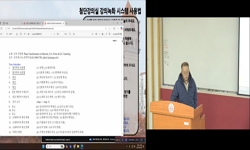Background: This research focuses on the simulation techniques for the migration and diffusion of aircraft radioactive material, evaluating the applicability and simulation performance of various modules.Materials and Methods: A multiscale meteorologi...
http://chineseinput.net/에서 pinyin(병음)방식으로 중국어를 변환할 수 있습니다.
변환된 중국어를 복사하여 사용하시면 됩니다.
- 中文 을 입력하시려면 zhongwen을 입력하시고 space를누르시면됩니다.
- 北京 을 입력하시려면 beijing을 입력하시고 space를 누르시면 됩니다.

Validation and Application of Migration Diffusion Mode in Nuclear Accident Consequence Evaluation System
한글로보기https://www.riss.kr/link?id=A109788725
-
저자
Lyu Minghua (Department of Nuclear Environmental Science Research, China Institute for Radiation Protection, Taiyuan City, China) ; Yao Rentai (Department of Nuclear Environmental Science Research, China Institute for Radiation Protection, Taiyuan City, China) ; Zhang Junfang (Department of Nuclear Environmental Science Research, China Institute for Radiation Protection, Taiyuan City, China) ; Zhao Duoxin (Department of Nuclear Environmental Science Research, China Institute for Radiation Protection, Taiyuan City, China) ; Huang Sha (Department of Nuclear Environmental Science Research, China Institute for Radiation Protection, Taiyuan City, China) ; Jia Jinglei (National Nuclear Emergency Response Technical Support Center, Beijing, China) ; Guo Li (National Nuclear Emergency Response Technical Support Center, Beijing, China) ; Liu Xinjian (National Nuclear Emergency Response Technical Support Center, Beijing, China) ; Tian Zhijie (Department of Nuclear Environmental Science Research, China Institute for Radiation Protection, Taiyuan City, China)
- 발행기관
- 학술지명
- 권호사항
-
발행연도
2025
-
작성언어
English
- 주제어
-
등재정보
KCI등재
-
자료형태
학술저널
- 발행기관 URL
-
수록면
105-111(7쪽)
- DOI식별코드
- 제공처
-
0
상세조회 -
0
다운로드
부가정보
다국어 초록 (Multilingual Abstract)
Background: This research focuses on the simulation techniques for the migration and diffusion of aircraft radioactive material, evaluating the applicability and simulation performance of various modules.Materials and Methods: A multiscale meteorological forecast simulation was developed to provide grid wind fields for dispersion modeling. In collaboration with the National Nuclear Emergency Response Technical Support Center, the China Institute for Radiation Protection has successfully developed the Nuclear Accident Consequence Assessment and DecisiOn Support System (NACADOS). This system, which has independent intellectual property rights, is specifically tailored to China’s national conditions and incorporates multiscale response capabilities for nuclear accident consequence assessment. This system also includes diffusion modules applicable to various evaluation scopes and environmental conditions.Results and Discussion: The effectiveness of the module’s assessment was validated through comparisons with on-site monitoring data, high-quality tracer experiment results (e.g. , European Tracer Experiment, Urban2000), and simulation outcomes from other consequence assessment systems (e.g. , Java-based Real-time On-line Decision Support System [JRODOS] and Radiological Assessment System for Consequence Analysis for radiological emergencies [RASCAL]). Furthermore, the functionality, performance, and effectiveness of the NACADOS system were rigorously tested through physical module validation, system testing, and engineering software testing.Conclusion: The NACADOS system meet the demands of radiological consequence assessment and response for nuclear and radiological emergencies worldwide, significantly enhancing nuclear emergency response capabilities.
동일학술지(권/호) 다른 논문
-
The 11th International Symposium on Radiation Safety and Detection Technology (ISORD-11)
- The Korean Association for Radiation Protection
- Chan Hyeong Kim
- 2025
- KCI등재
-
- 대한방사선방어학회
- Sasaki Miyuki
- 2025
- KCI등재
-
Radioactivation Investigation for Concrete in Synchrotron-Type Proton Therapy Facilities
- 대한방사선방어학회
- Matsumura Hiroshi
- 2025
- KCI등재
-
Investigation on Decision-Making Criteria for Public Protective Actions in Nuclear Emergencies
- 대한방사선방어학회
- 하위호
- 2025
- KCI등재




 ScienceON
ScienceON eArticle
eArticle






